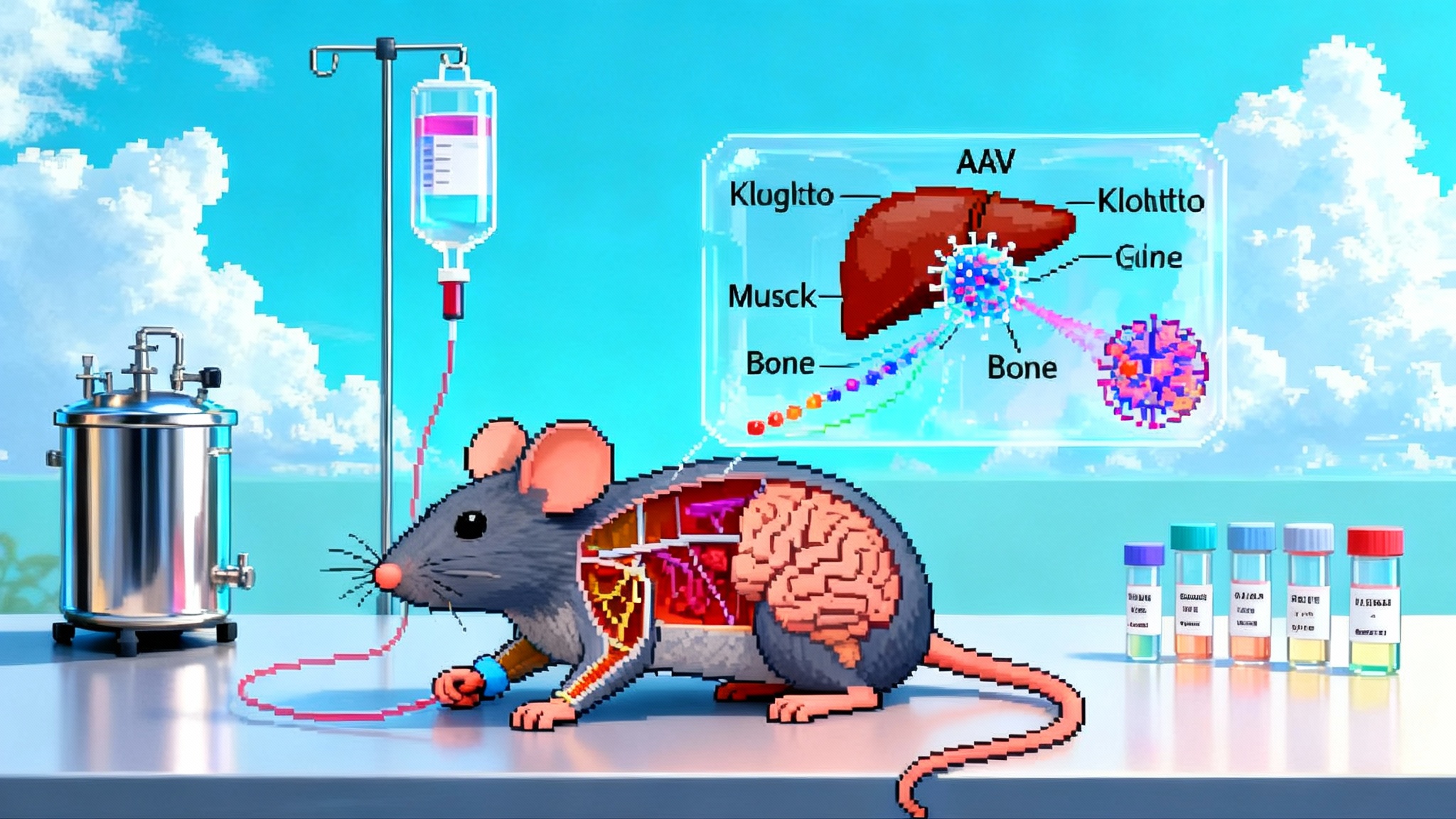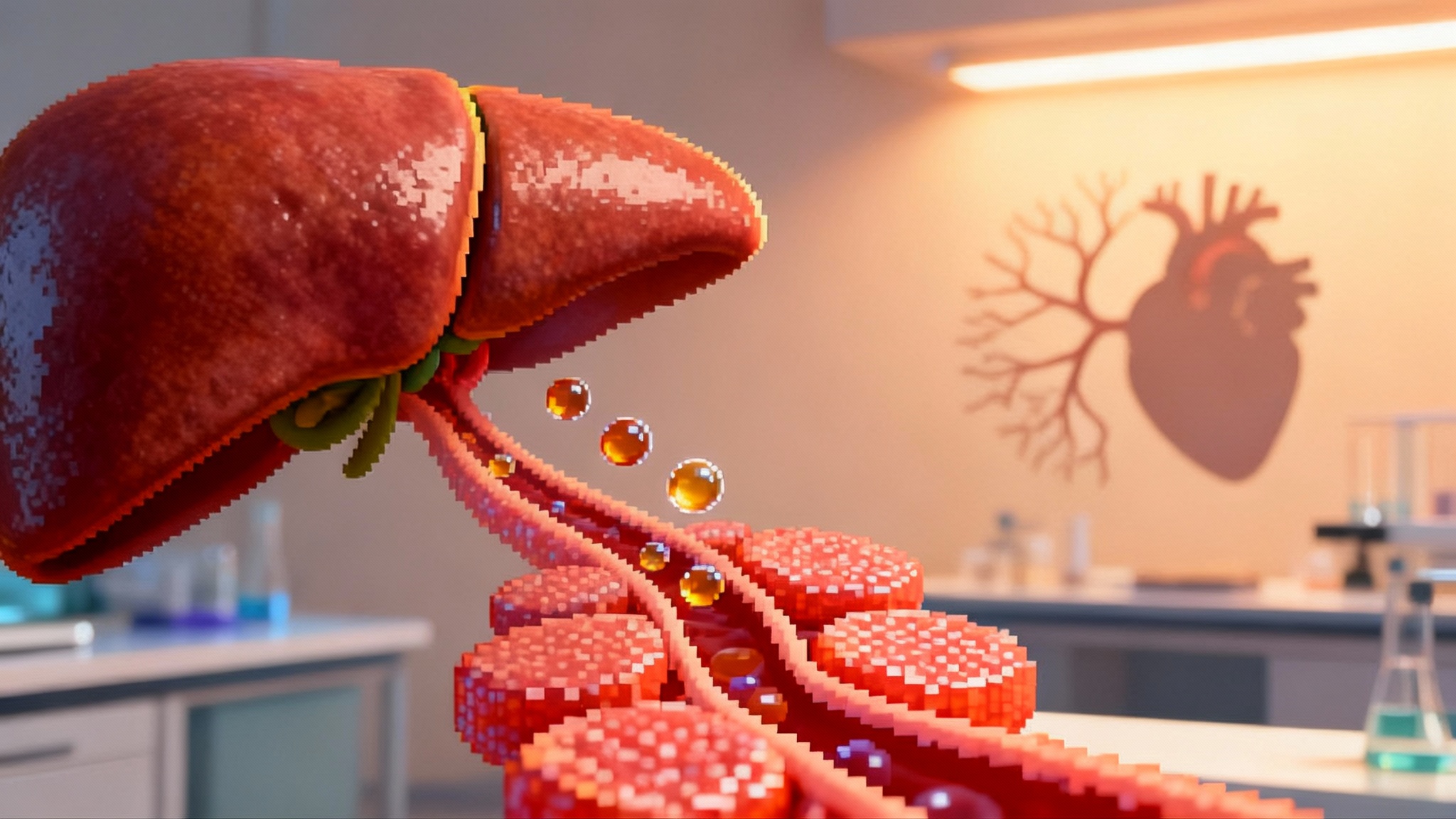From longer-lived mice to humans: Klotho therapy’s 2025 pivot
A single AAV dose of secreted Klotho extended male mouse lifespan in a 2025 study, while a biotech began manufacturing an AAV‑Klotho candidate for ALS. Here is the biology, delivery tradeoffs, safety map, endpoints, and timelines that matter now.

From mouse longevity to human readiness in 2025
If you follow longevity science, you likely saw the headline this spring: one dose of an AAV vector that makes cells secrete Klotho increased male mouse lifespan by roughly twenty percent and improved markers across muscle, bone, and brain. The peer reviewed study described AAV9 delivery of secreted Klotho with survival gains in males treated at 12 months of age, and a broad slate of functional benefits. You can read details in the April 2025 Molecular Therapy study.
At almost the same time, a US biotech announced it is preparing manufacturing runs for an AAV Klotho candidate to support first in human studies focused on a disease indication. That convergence is why 2025 feels like a pivot point. The science is maturing, the tools to make clinical grade vectors are being locked in, and investors are paying attention. But expectations still need calibration. This piece lays out what Klotho actually does, why delivery and dose will decide outcomes, how to think about safety and tumor risk, where sex differences fit, what regulators will accept, and what the next few years can realistically prove.
What Klotho actually is
Klotho is a gene named after one of the Fates in Greek mythology. In mammals, the alpha Klotho gene produces two major protein isoforms with different jobs:
- Membrane Klotho (m‑KL). A full length protein anchored in cell membranes, most abundant in kidney and parathyroid. It partners with FGF23 to regulate phosphate and vitamin D metabolism. When m‑KL is missing, phosphate balance goes awry and mice develop a rapid aging phenotype.
- Secreted Klotho (s‑KL). A shorter, soluble isoform that circulates in blood and acts more like a hormone. It modulates several pro growth and stress pathways, including insulin and IGF‑1 signaling and Wnt, and shows anti inflammatory and anti fibrotic effects across tissues.
You can think of m‑KL as a gatekeeper for mineral homeostasis and s‑KL as a system wide tuner that keeps multiple age sensitive pathways from drifting too far. The 2025 mouse study elevated the secreted isoform, not the membrane one, and that choice matters for how a human therapy will be designed.
The new mouse data at a glance
The 2025 work used an AAV9 vector encoding s‑KL. Researchers dosed wild type mice at two ages. Males treated at 12 months lived longer than controls, with increased median and total survival. The same protocol applied at 6 months did not increase lifespan, which the authors attribute to lower sustained s‑KL levels in that cohort. Females could not be evaluated for lifespan because many were euthanized for dermatitis and bleeding that confounded longevity measurement, but females did show improvements in bone microstructure and other health markers.
Practical insights from the study:
- Isoform choice matters. The benefits were seen with the secreted form of Klotho.
- Route matters. Researchers combined intravenous and intracerebroventricular dosing to reach both periphery and brain. That was acceptable for proof of mechanism but is not how a broad human therapy would be given.
- Age at treatment matters. The same vector gave different results depending on when it was dosed, likely because vector exposure and tissue growth affect long term expression.
- Benefits spanned organs. Muscle regeneration improved, fibrosis decreased, neurogenesis markers rose, and bone metrics improved, suggesting multi tissue effects aligned with Klotho’s signaling footprint.
Delivery and dosing will make or break this
Gene therapies are often limited not by what they express but by where and how much. Klotho is no different.
- Vector choice and tropism. AAV9 is a workhorse with strong muscle and liver tropism and some ability to reach the central nervous system. Newer capsids can increase brain delivery after a standard intravenous infusion. A human program will try to hit key tissues while sparing the liver enough to reduce toxicity.
- Promoter and expression level. The 2025 study raised serum s‑KL into a therapeutic window. In humans, expression must be high enough to move biomarkers but not so high that you push phosphate regulation off target or trigger unexpected pathway crosstalk.
- Dose and durability. AAV vectors generally persist for years in nondividing tissues. Sustained s‑KL was a prerequisite for benefit at 12 months in mice. In growing or regenerating tissues, expression can drift downward as cells divide, which implies different dose selection for adults versus adolescents.
- Route of administration. Dual intravenous plus intracerebroventricular dosing is unlikely in a broad indication. A realistic plan is an intravenous dose with a brain penetrating capsid, possibly paired with tissue specific promoters to bias expression.
- Pre existing immunity. Many adults have antibodies against common AAVs. Screening, dose adjustment, or the use of less prevalent capsids can mitigate but not eliminate this issue.
For context on adjacent regenerative strategies and delivery choices, see thymus rejuvenation efforts in 2025.
The safety ledger and tumor risk questions
Every AAV program faces a similar risk map. The main items for Klotho are familiar but worth spelling out.
- Acute liver stress. Transient elevations in liver enzymes and immune responses to the vector capsid are common and dose related. Modern steroid protocols and careful dose escalation can help, but monitoring must be strict in early cohorts.
- Off target tissue effects. Overexpressing s‑KL changes signaling in many organs. Safety monitoring should include electrolytes and phosphate, vitamin D status, bone turnover markers, insulin sensitivity, and cardiac function.
- Integration and cancer risk. AAV is primarily episomal, but low frequency integration can occur. Adult human risk appears lower than neonatal mouse risk, yet regulators will require long term follow up and careful necropsy in large animal toxicology.
- Does Klotho alter tumor risk. Klotho dampens IGF and Wnt signaling that tumors use to grow, which argues for potential tumor restraint. A broadly pro homeostatic milieu could in principle help a nascent tumor tolerate stress. The prudent stance is to treat tumor surveillance as a must have endpoint, not a theoretical afterthought.
The sex difference puzzle
The 2025 paper reports extended lifespan in males treated at 12 months, but not in females, because many females were lost to dermatitis and bleeding that forced euthanasia. That complicates interpretation. At the same time, females showed some of the clearest improvements in bone microstructure, pointing to true biological benefit. The simplest read is that Klotho biology is real in both sexes, but the specific longevity result could only be tested in male mice this time. A human program should plan for sex balanced enrollment, prospectively track dermatologic events, and analyze bone and muscle outcomes with sex as a predefined covariate.
Companies move toward first in human
In June 2025, a US company developing a secreted Klotho AAV reported it was moving forward with manufacturing and process development work to prepare for clinical trials in ALS, a disease specific entry point compatible with existing FDA pathways. The announcement emphasized tissue targeted vectors and scalable production to support IND enabling studies manufacturing plan for ALS trials.
Why ALS first:
- Disease specific endpoints exist and survival is measurable over 18 to 24 months.
- Preclinical data suggest Klotho can modulate neuroinflammation and support neuronal resilience, which is mechanistically relevant to motor neuron disease.
- FDA has well trodden ground for early ALS gene therapy trials, which keeps the path clearer than a first shot at a primary aging claim.
For perspective on how geroscience is entering pragmatic trials, see frailty and aging trials at St. Jude.
What regulators will accept in the near term
There are two distinct regulatory lanes.
- Disease specific indications. The likely starting point. Expect a standard first in human design with dose escalation and careful safety monitoring. Primary endpoints will be safety and tolerability. Secondary endpoints will include pharmacokinetics and pharmacodynamics, such as serum s‑KL levels, changes in phosphate and vitamin D axes, inflammatory cytokines, and tissue specific biomarkers. For ALS, you would add ALSFRS‑R slope, respiratory measures, and survival. For cognitive disorders, you would pair safety with fluid biomarkers and cognitive scales. For sarcopenia, you would collect strength, gait speed, and body composition. Any early efficacy claims should be framed as exploratory. Related biomarker infrastructure is expanding after FDA’s 2025 LDT rollback.
- Geroprotective claims. Aging itself is not an FDA indication. To make a claim like slows age related decline, sponsors must either anchor to a defined disease or work within a framework that uses accepted surrogate endpoints in a specific organ system. A true lifespan or universal healthspan claim would require decade scale studies and is not a near term goal.
A smart development plan will show target engagement across tissues, reduce a disease relevant biomarker, and provide a hint of clinical benefit in a focused population, all while keeping safety clean.
Realistic timelines from the 2025 pivot
Timelines vary, but the manufacturing note in mid 2025 offers a useful anchor. Here is a realistic sequence for a small gene therapy company starting now:
- Process development and test runs for clinical grade vector. Six to twelve months, including analytics, release assays, and stability work.
- IND enabling toxicology. Typically one rodent and one large animal study with genomic integration screens and biodistribution, nine to twelve months, often overlapping with manufacturing.
- Pre IND interactions and IND submission. Late 2026 is plausible if everything hits on time. Early 2027 is realistic once you factor in iteration.
- First in human dosing. Within a quarter of IND clearance.
- First readouts. Safety and pharmacodynamics within three to six months. Exploratory clinical signals within 12 months, depending on the disease.
- Pivotal planning. Only after a clean safety profile and a convincing biomarker story, which lands you in 2028 or later.
These are conservative and assume no major surprises. Vector immunogenicity, batch failures, or new FDA guidances can stretch any step by months.
What near term clinical data can actually prove
It cannot prove more years of life. That is the trap headline. Here is what it can show in the first two years if things go well:
- Safety at a given dose and route in adults, including acceptable liver enzyme profiles and manageable immune reactions.
- Target engagement, shown by sustained elevations in circulating s‑KL and predictable movement in phosphate and vitamin D biology without safety tradeoffs.
- Tissue relevance, via muscle, bone, or brain biomarkers that track with the preclinical story, such as bone density trends in an osteopenic subgroup or neuroinflammation markers in a neurodegenerative disease.
- Early directional signals in a disease context, such as a slower ALSFRS‑R decline in ALS or improved gait speed in a sarcopenia adjacent population. These will be hypothesis generating, not confirmatory.
How to read Klotho headlines in 2025
- Ask which isoform. If the work elevates secreted Klotho, the result is more relevant to the current therapeutic path.
- Check the route. Intracerebroventricular dosing in mice shows mechanism. An intravenous brain penetrating vector is the human goal.
- Look for dose and serum levels. A clear relationship between dose, s‑KL levels, and biomarkers is more informative than a single survival number.
- Separate lifespan from healthspan. Mouse survival was the attention getter. Multitissue functional benefits may be the more practical clinical targets.
- Watch for sex specific data. Human trials should predefine sex based analyses, given the mixed ability to evaluate female longevity in the mouse experiment.
- Confirm the indication. If the claim is anti aging, it is probably marketing. If the claim is ALS or another disease with accepted endpoints, it is on a real regulatory track.
The bottom line
Klotho has moved from an attractive target to a testable therapeutic concept. In 2025, we saw credible, peer reviewed evidence that a one time AAV delivered, secreted Klotho can extend male mouse lifespan and improve multiple organ systems, paired with the first steps to manufacture clinical grade vectors for disease focused human trials. The biology argues for multi tissue benefits. The delivery and dosing details will decide success or failure. Safety must be earned the hard way, one cohort at a time. Regulators will bless disease specific claims long before any geroprotective label. If you align your expectations with that reality, the next few years could still be a watershed for translating a classic longevity gene into real human data.







